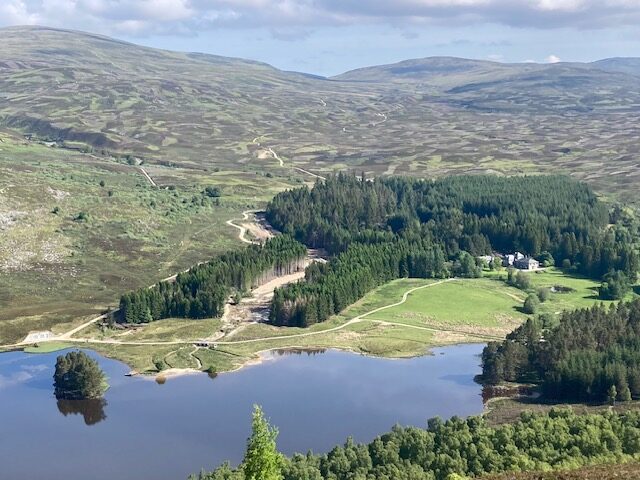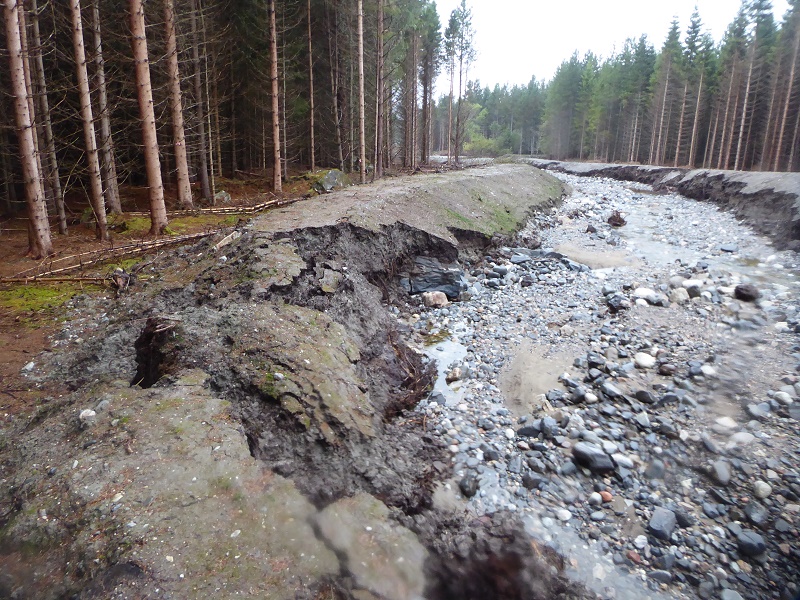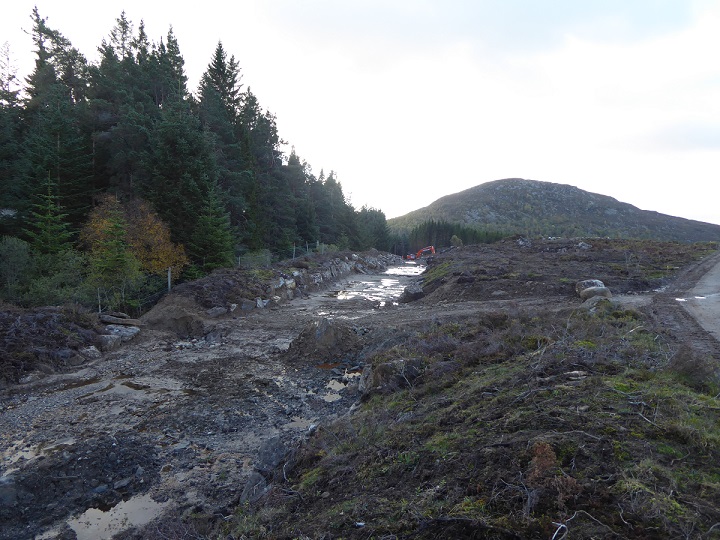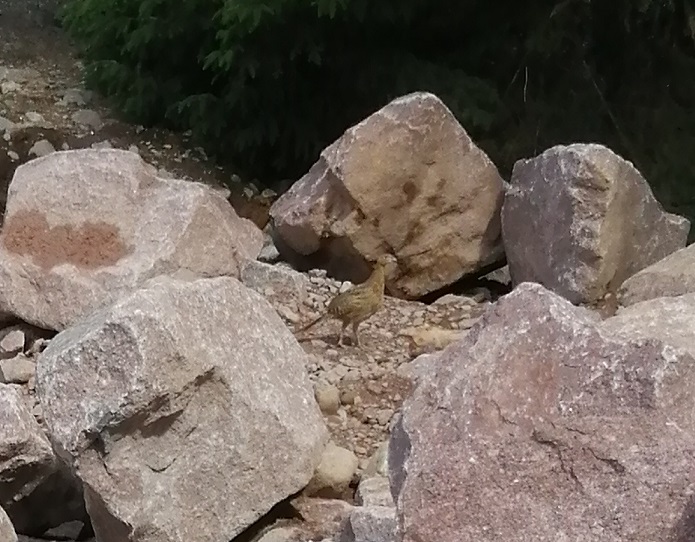
The “repairs” (see here), (here), (here), (here) and (here) to the failed overflow channel between the Allt Mhor and Loch Gynack, intended to reduce flood risks in the village of Kingussie below and unused since 2018, are extensive. Indeed the evidence suggests the whole of the original footprint has been re-worked and this is not a repair but rather a re-construction of the original channel built in 2017. Despite this not a single new document has been published by the Cairngorms National Park Authority (CNPA) on its planning portal (see here) since October 2017. There is nothing to explain either why the original construction failed so completely or why the new one will work.
The dereliction of duty on the part of our public agencies here is not just about ensuring that engineering of water courses is fit for purpose (the CNPA have not yet responded to question I asked on 11th June about whether any plans had been submitted by the estate) or that sensitive river systems are protected from silt (it was flowing into the River Gynack for two months) its about tackling the source of the problems. The photo above brilliantly shows the extent of the muirburn above the intake of the overflow, located at the top left of the plantation. Muirburn destroys trees and bog forming plants, both of which would help to hold retain water above Kingussie, and caused more rapid water run-off when it rains. Intensive grouse moor management by the Pitmain estate has been the main contributor to the flood problem in the first place.
To rub salt into the wound, Majid Jafar, whose family owns Pitmain, is the Chief Executive of Crescent Petroleum which, like other fossil fuel companies, bears a high degree of responsibility for the climate crisis and the consequent increase in extreme flood events which have threatened places like Kingussie.
Despite all this, Highland Council paid Pitmain over £100k towards the original cost of the channel while NatureScot continues to fork out public money to the estate for Peatland Restoration (see here).
The current work appears to include reinforcing/replacing sections of earth bank with rip rap bouldering:


The design and construction of the banks along the lower sections of the channel was even worse and completely unfit for purpose:

Clearly, something had to be done but whether the finished item is any more likely to work than the last one is a moot point.

Comparing this with a photo from a similar viewpoint showing how the channel looked during construction in October 2017 shows that while the work has been extensive many of the original design flaws have been repeated:

From the photos it appears that bank on the left may be slightly broader and the channel itself slighty narrower than previously. This suggests that the water that will be diverted down it may be less than originally planned. However, the rip rap bouldering and floor of the channel looks little different to what was done previously. As my post back in November 2019 showed both eroded seriously as soon as the channel was used (see here). Despite my call for the CNPA and others to investigate what lessons could be learned from this engineering disaster, no-one appears to have done this.
The recent photo also shows that so far there has been no attempt to restore any of the vegetation on the right bank and it is flatter than previously, creating an unnatural landscape.
From an engineering perspective the new channel looks to me like another disaster waiting to happen. On the first serious flood, what is to stop some of the rip rap boulders being plucked from the banks or to prevent the loose debris on the floor of the channel being swept away once again, releasing yet more silt into the river system? Time will tell but if the channel fails the Scottish Parliament’s Climate Change Committee, part of whose role is to look at how Scotland is adapting to Climate Change, should investigate.
One hopes too that the new Convenor of the CNPA, Sandy Bremner, who is Chair of the River Dee Trust and whose biographical details (see here) states this is “one of the biggest nature-restoration projects in the Cairngorms”, might be interested in the engineering of the Gynack overflow which appears to follow no ecological principles. Given his stated “determination that nature and people should thrive at a time of major challenges for both”, the management of the Gynack overflow planning application and land-use on the Pitmain Estate looks like a pretty good place to start. I will write suggesting a site visit!
Meantime, it is rumoured that the current work is due to be completed by 1st August, just before the Jaffar family return to Pitmain for the annual shooting jamboree. Whether the intensive grouse moor management on the estate has produced enough grouse this year to satisfy their appetites is unclear but, if not, there is a plentiful supply of pheasants as the sharp-eyed among readers may have spotted from the photo above!


There is no climate crisis; carbon dioxide is an essential gas, not some pollutant nor ‘greenhouse’ contributor: https://youtu.be/3q-M_uYkpT0 [Ed. Your statement that there is no climate crisis and CO2 is not a greenhouse gas is completely false ]
Keep in mind also the natural emissions of volcanoes, which dwarf those of Man’s endeavours:
https://youtu.be/3BJKY1fiSdc
All modelling of climate change is worthless, based upon incomplete and erroneous data. [Ed. Again completely false]
By the way, pheasant shooting season does not begin until October. Many locals benefit from beating jobs and ancillary work surrounding the activity.
And the Red Partridge season, which in former years anyway have been released in quantity on the Pitmain Estate, does not start until 1st September. If you have any information on how many local people are paid as beaters, for how many days of the year and what they are paid for doing this, I would be very interested in hearing that.
As Nick has already indicated, Freeforester’s comments about CO2 are nonsense, and the two YouTube video’s to which he links are sources of misinformation, designed to fool the uninformed.
All of the measured increases in atmospheric CO2 in recent centuries has been caused by human emissions, with the natural environment acting as a net sink of CO2 – ie. the natural environment has absorbed more CO2 than it has emitted since 1750, and is NOT the cause of the increase in atmospheric CO2.
The amount of CO2 produced annually by volcanoes is i) less than 1% of that emitted by human activities and ii) has not varied significantly in recent times, and cannot possibly be the cause of the rise in atmospheric CO2.
Likewise, the geothermal heat flow (mentioned by the second video) varies between 0.065 W/m2 over continental crust and 0.101 W/m2 over oceanic crust, whereas the heat flow received from the sun averages around 240 W/m2, ie geothermal heat flow provides around 0.04% of the energy provided by the sun, and cannot possibly be the source of global warming.
“Many locals benefit from beating jobs and ancillary work surrounding the activity”.
Surely by now this should be recognised as convenient myth put about by those actively involved in shooting across most regions of Scotland today? If these numbers were to be compared with the unseen mass of people who take to the hills for leisure today, then the huge numbers employed in the service sector, food supply industry, hotels, hostels, holiday houses and campsites, hugely outweigh the few actively involved with shooting. Hunting becomes a rather marginal sector when now compared with year round employment needed to provide for more peaceful recreation.
Few outsiders to the shooting parties would ever manage to go out on the hills in order to assess “local involvement”. Without some real independent scrutiny surrounding supposed numbers employed in “shooting”, this scary self-serving myth, put about by big estates, still makes the running. It seems very unlikely that today’s SGA can be seen as a reliable source of the necessary statistics. It is far more obvious that local employment provided by the seasonal holiday accommodation sector (eg: for ramblers and outdoor enthusiasts seeking peace ) , the need for property maintenance, builders, ground workers, gardeners, plumbers, painters electricians, domestic cleaners, laundry, and the rest … furnish steady numbers in other employment sectors . by how much do these year round jobs outweigh those who may find today casual work, just to facilitate an occasional seasonal killing spree for the few.?
Might be a tad more professional to keep personal opinions out of the journalism?
I was expecting to read an article about overflow run off improvements and instead found myself enduring eco claptrap whinging about a petrochemical company.
If parks journalists are going to make such claims at least make an effort to support them with facts because without facts, figures or links to support them it is simply whining.
If I was seeking a whining, fact free opinion based on feelz falsely claiming an individual is to be held accountable for totally unproven and very dangerous ideology I would have opened a story written by Greta Thunberg.
I didn’t do that for a reason.
Stick to the parks please!
I am a campaigner, not a journalist and if you don’t like what I say about our failures to address the crises that threaten humanity (in this case land-use, inappropriate engineering) you don’t have to read it. As for facts, these are very important which is why parkswatch uses photos where possible, to show what is actually happening on the ground.